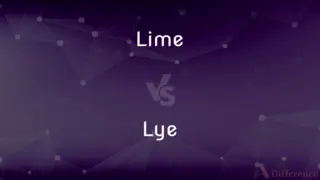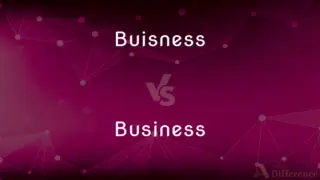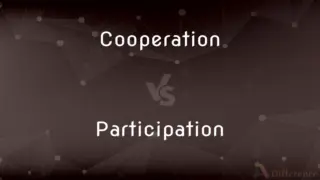Normal Goods vs. Inferior Goods — What's the Difference?
By Tayyaba Rehman — Published on October 9, 2023
Normal Goods see increased demand as income rises, whereas Inferior Goods see decreased demand as income rises.

Difference Between Normal Goods and Inferior Goods
Table of Contents
ADVERTISEMENT
Key Differences
For a consumer, Normal Goods represent products or services that they buy more of when their purchasing power goes up. For Inferior Goods, even if they might be affordable, people tend to buy less of them as they become wealthier or when the economy thrives.
Tayyaba Rehman
Oct 09, 2023
Normal Goods have a direct relationship with income: as people's income increases, the demand for these goods rises. Inferior Goods, conversely, have an inverse relationship: when income rises, the demand generally decreases.
Tayyaba Rehman
Oct 09, 2023
One of the fascinating things about Normal Goods is that they can range from necessities to luxury items. Whether it's staple food or a high-end car, if the demand rises with income, it's a Normal Good. Inferior Goods, on the other hand, might be considered less desirable alternatives to more expensive products. They are often the choices people resort to when budget constraints are tight.
Tayyaba Rehman
Oct 09, 2023
Factors such as consumer perceptions, quality, and alternatives available in the market often play into these classifications. Brands might aim to ensure their products are seen as Normal Goods. Conversely, Inferior Goods, while often being more affordable, might not be a consumer's first choice if given a higher income level.
Tayyaba Rehman
Oct 09, 2023
Lastly, it's essential to understand that the categorization isn't static. What's seen as a Normal Good in one economic scenario or culture might be an Inferior Good in another. The dynamic nature of economies and consumer preferences plays a pivotal role in these designations.
Tayyaba Rehman
Oct 09, 2023
ADVERTISEMENT
Comparison Chart
Income Relationship
Direct (Demand rises with income)
Inverse (Demand falls with income)
Tayyaba Rehman
Oct 09, 2023
Consumer Preference
Preferred with higher income
Less preferred with higher income
Tayyaba Rehman
Oct 09, 2023
Economic Significance
Reflect economic growth and prosperity
Indicate financial constraints or economic downturn
Tayyaba Rehman
Oct 09, 2023
Nature
Can be necessities or luxuries
Often seen as less desirable alternatives
Tayyaba Rehman
Oct 09, 2023
ADVERTISEMENT
Definitions
Normal Goods
Items consumers purchase more of when their financial situation improves.
High-end electronics are often seen as Normal Goods in prosperous economies.
Tayyaba Rehman
Oct 03, 2023
Inferior Goods
Goods for which demand decreases as consumer income rises.
Ramen noodles are often seen as an Inferior Good because people buy less of them as they earn more.
Tayyaba Rehman
Oct 03, 2023
Normal Goods
Commodities that witness growing popularity with economic prosperity.
Fine dining experiences are Normal Goods, with more patrons as income levels rise.
Tayyaba Rehman
Oct 03, 2023
Inferior Goods
Products with a negative income elasticity of demand.
As his earnings grew, John used less public transportation, an Inferior Good, and opted for a car.
Tayyaba Rehman
Oct 03, 2023
Normal Goods
Goods for which demand increases as consumer income rises.
Organic produce is a Normal Good because more people buy it when they have higher incomes.
Tayyaba Rehman
Oct 03, 2023
Inferior Goods
Products witnessing reduced sales with enhanced purchasing power.
People might opt for branded products over generic ones, considering the latter as Inferior Goods, when they have more disposable income.
Tayyaba Rehman
Oct 03, 2023
Normal Goods
Products that have a positive income elasticity of demand.
As her salary increased, Jane started buying more designer clothing, a Normal Good.
Tayyaba Rehman
Oct 03, 2023
Inferior Goods
Items that consumers purchase less of when their financial situation improves.
Canned soup might be considered an Inferior Good if people prefer fresh soup with higher incomes.
Tayyaba Rehman
Oct 03, 2023
Normal Goods
Products that see augmented sales with increased purchasing power.
Luxury vacations are considered Normal Goods because demand surges when people earn more.
Tayyaba Rehman
Oct 03, 2023
Inferior Goods
Commodities often replaced by superior alternatives as income increases.
Second-hand clothing, while economical, is often viewed as an Inferior Good in affluent societies.
Tayyaba Rehman
Oct 03, 2023
FAQs
Are luxury items always considered Normal Goods?
Not necessarily, but they often are, as their demand rises with income.
Tayyaba Rehman
Oct 09, 2023
Why might someone buy more of an Inferior Good when their income is lower?
They might see it as a more affordable or practical choice given budget constraints.
Tayyaba Rehman
Oct 09, 2023
How does income influence the demand for Normal Goods?
As income rises, the demand for Normal Goods typically increases.
Tayyaba Rehman
Oct 09, 2023
What happens to the demand for Inferior Goods when income goes up?
The demand generally decreases.
Tayyaba Rehman
Oct 09, 2023
Are Inferior Goods always of low quality?
No, they might be of decent quality but are just less preferred with higher income.
Tayyaba Rehman
Oct 09, 2023
Are essential items always Normal Goods?
Not always. While many essentials are Normal Goods, some can be Inferior Goods in certain contexts.
Tayyaba Rehman
Oct 09, 2023
How is the elasticity of demand related to these goods?
Normal Goods have positive income elasticity; Inferior Goods have negative income elasticity.
Tayyaba Rehman
Oct 09, 2023
Can the classification of goods change over time?
Yes, depending on economic conditions and consumer preferences.
Tayyaba Rehman
Oct 09, 2023
Can a product be both a Normal Good and an Inferior Good?
Not simultaneously, but its categorization can change based on economic or cultural factors.
Tayyaba Rehman
Oct 09, 2023
How do producers view these categorizations?
Producers often aim for their products to be seen as Normal Goods, as this signifies greater demand with economic growth.
Tayyaba Rehman
Oct 09, 2023
Author Spotlight
Written by
Tayyaba RehmanTayyaba Rehman is a distinguished writer, currently serving as a primary contributor to askdifference.com. As a researcher in semantics and etymology, Tayyaba's passion for the complexity of languages and their distinctions has found a perfect home on the platform. Tayyaba delves into the intricacies of language, distinguishing between commonly confused words and phrases, thereby providing clarity for readers worldwide.

















































